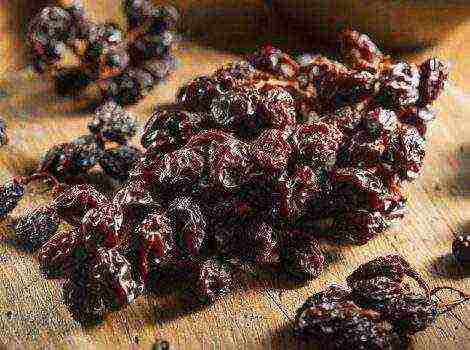Content [show]
Tall blueberry, or garden blueberry, is a beautiful and healthy plant. By planting bushes of one of these 10 varieties around the perimeter of the garden, you will get a charming hedge that every summer will delight you with a rich harvest of delicious and very healthy berries.
Gardeners began to cultivate wild blueberries only 100 years ago, so we can safely say that garden blueberries are a young culture. This berry is attractive both as an ornamental plant and as a berry shrub, which gives a high-quality, tasty, vitamin-rich harvest.
If for some reason you still have not managed to "settle" tall blueberries in your garden, we advise you to try one of these varieties.
1. Bluegold
This popular blueberry variety is light blue with a dense, aromatic flesh. And the bushes themselves are lush and beautiful, so they will be a wonderful decoration for any garden. However, it should be borne in mind that spreading is at the same time a lack of bushes of this variety, because they require strong pruning.
Bluegold is an early variety. The fruits acquire a rich color at the beginning of summer and ripen amicably by mid-July. From one bush, from 4.5 kg of berries are harvested, even in not the most productive years.
This blueberry can withstand frosts down to -35 ° C, therefore it is suitable for growing in northern regions. The weak side of the variety is that its berries wilt quickly, mummify, especially if the summer is hot.
Bluegold berries crumble when overripe, so it is important to harvest on time!
| Maturation | Bush height (m) | Berry diameter (mm) | Productivity (kg per bush) | Peculiarities |
| Mid july | 1,2-1,5 | 16-18 | 4,5-7 | High frost resistance |
2. Bluecrop
This mid-season American blueberry was developed over half a century ago. Berries are light blue, large with firm pulp. They can be easily identified by their characteristic flattened shape.
It is worth planting several Bluecrop bushes on your site because the plants of this variety are not afraid of snow, or heat, or pests and viruses, and the fruits themselves do not crack when overripe, withstand transportation with dignity, are well stored and do not lose their rich taste when frozen.
| Maturation | Bush height (m) | Berry diameter (mm) | Productivity (kg per bush) | Peculiarities |
| End of July - August |
1,6-1,9 | 17-20 | 6-9 |
Disease resistance, |
3. Blurey
What gardener does not dream of a shrub that will delight with lush flowering in spring, excellent harvest in summer and fabulously beautiful fiery foliage in autumn? If you were looking for such a plant, consider that you have already found it! Blueberries of the Blurey variety don a romantic pink dress in spring and change to a fiery red dress in the fall.
The berries are juicy, very sweet, shiny, deep blue in color. The bushes are literally strewn with them, tk. Blurey gives not just a bountiful, but an excessive harvest. However, excessive fruiting is at the same time a disadvantage of the variety, because it depletes the plant. When choosing blueberries of this variety for your garden, this feature should be taken into account.
The variety has another strong side - it is very winter hardy. Blueberries Blurei can withstand frosts down to –34 ° С.
These berries are best eaten fresh. Moreover, they remain so for a long time and do not crack even when they are overripe.
| Maturation | Bush height (m) | Berry diameter (mm) | Productivity (kg per bush) | Peculiarities |
| End of july | 1,2-1,8 | 12-17 | 5-8 | Prone to excessive fruiting |
4. Bonus
If you see a coin-sized blueberry on the market, there is a 99.9% chance of it being a Bonus berry. Perhaps this is the largest-fruited tall blueberry that can be grown in your summer cottage.
The berries themselves are fragrant, dense, sweet. They are suitable both for fresh consumption and for freezing. This blueberry gives a good harvest and tolerates frosty winters with dignity. Isn't it a gardener's dream?
|
|
||||
| Maturation | Bush height (m) | Berry diameter (mm) | Productivity (kg per bush) | Peculiarities |
| July August | 1,5-1,6 | 20-30 | 5-8 | Good winter hardiness |
5. Herbert
Herbert blueberry is one of the best you can grow in your garden. This is in the full sense of the word a tall blueberry - the height of a bush can reach 2.2 m!
Of course, the fruits are not as gigantic as those of the Bonus, but they are still quite large - about 2 cm in diameter. They have a delicate taste, they do not crumble or crack when overripe.
The bushes of this variety multiply easily, winter well, give up to 9 kg of harvest per season and are unlikely to cause you much trouble.
| Maturation | Bush height (m) | Berry diameter (mm) | Productivity (kg per bush) | Peculiarities |
| Mid august | 1,8-2,2 | 20-22 | 5-9 | Reproduces easily |
6. Jersey
This is an old variety of tall blueberries, tested by thousands of gardeners. If you expect undemanding care and a stable harvest from a berry bush, even in not the most favorable years, you will definitely like Jersey.
Blueberries of this variety take root well on different types of soils, tolerate frosts well, and are resistant to diseases and viruses, in particular, to the red ring spot virus.
Jersey berries are small, light blue and round in shape. Due to their delicate sweet taste, they are perfect for processing: making homemade cakes, jam, compotes. In addition, the blueberry harvest of this variety is well stored and suitable for freezing.
|
|
||||
| Maturation | Bush height (m) | Berry diameter (mm) | Productivity (kg per bush) | Peculiarities |
| Mid august | 1,6-2 | 15-16 | 4-6 | Virus resistant red donut blotches |
7. Duke
This variety is extremely popular in its homeland in America. And this is not surprising: the plants are resistant to frost, consistently give a high yield. Duke bushes are not afraid of spring frosts, because they bloom late, but they bear fruit quite early - already in mid-July.
The berries of this variety are "robust" with excellent taste and pleasant aroma.But keep in mind that during the ripening period, branches "loaded" with crops may break off, so it is advisable to tie them up.
| Maturation | Bush height (m) | Berry diameter (mm) | Productivity (kg per bush) | Peculiarities |
| Mid july | 1,2-1,8 | 17-20 | 6-8 | Not afraid spring frosts |
8. Northland
This variety is quite consistent with its name (translated from English "Northland" means "North Country") and is suitable for growing even in cold regions. American gardeners claim that Northland bushes can withstand frosts down to -40 ° C and consistently produce 4-8 kg of delicious berries.
The fruits of this blueberry are medium-sized, very sweet, so they are ideal for fresh consumption and for making jams and preserves.
The variety is resistant to pests and diseases, including the berry mummification virus. Northland bushes are "stocky", not tall. In the vicinity of other bushes of similar height, they can form a beautiful hedge on the site.
|
|
||||
| Maturation | Bush height (m) | Berry diameter (mm) | Productivity (kg per bush) | Peculiarities |
| Second half of July | 1-1,2 | 15-17 | 4-8 | Withstands frost down to -40 ° С |
9. Patriot
Bushes of this variety thrive in any type of soil, although heavy, well-moistened soils are most fond of. They also winter well, they are not afraid of late blight and stem cancer.
This variety has an interesting feature: in the process of ripening, the berries change color from green to red and only at full maturity acquire the usual dark blue color. The fruits ripen early - already in mid-July, they taste pleasant, sweet.
|
|
||||
| Maturation | Bush height (m) | Berry diameter (mm) | Productivity (kg per bush) | Peculiarities |
| Mid july | 1,2-1,8 | 17-19 | 4,5-7 | Resistant to late blight |
10. Elizabeth
Elizabeth blueberries are considered one of the leaders in taste and aroma. Her berries are large, firm, sweet - it is impossible to resist! The fruits do not ripen all at once, but within two weeks, so you will have the opportunity to "stretch" the pleasure. Please note that sometimes some of the berries do not have time to ripen.
The indisputable advantage of Elizabeth blueberries is the ease of reproduction (it is best propagated by lignified cuttings). But the variety has one feature - the plants do not develop well on sandy soil. Ideally, the soil should contain some peat.
The Elizabeth variety was named after an American woman. Elizabeth White, The "progenitor" of garden blueberries.
| Maturation | Bush height (m) | Berry diameter (mm) | Productivity (kg per bush) | Peculiarities |
| Early august | 1,6-1,8 | 14-17 | 4-6 | Fruiting is stretched by time |
From the whole variety of blueberry varieties, we have selected 10 of the most proven ones, which will certainly thank you for their excellent appearance and delicious harvest. I wonder which kind of garden blueberry will you choose?
Blueberries are not just a tasty and healthy berry, which is even recommended for overweight people, but also very expensive, because in most CIS countries this berry can cost more than selected beef.
Given this fact, today we will consider the best varieties of blueberries that can be grown in any summer cottage, and which will regularly bring such a valuable berry to your table!
The best varieties of blueberries with photos
If you decide to grow a blueberry bush in your garden or vegetable garden, be sure to pay attention to the following varieties:
Hardible
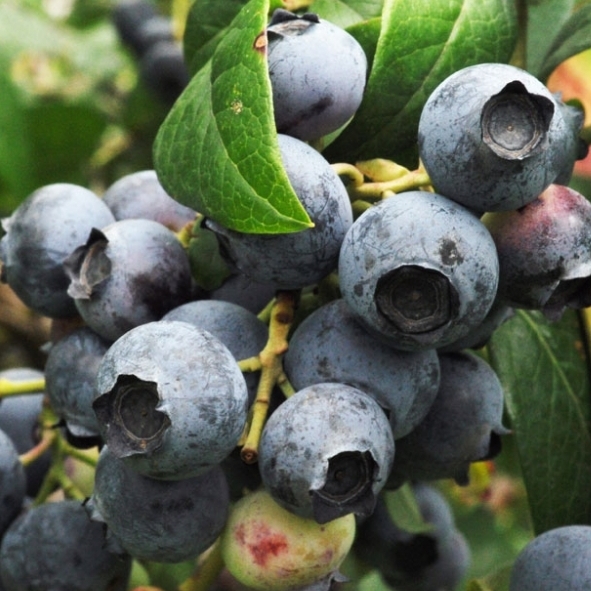
This blueberry variety has one of the largest bushes in the entire family, which grows up to 2 or sometimes more meters. The shrub has strong and resilient branches that can easily withstand strong gusts of wind, reliably holding the crop.
Separately, it is worth mentioning the high resistance of the shrub to cold weather, because it calmly withstands winters with temperatures down to -25 degrees, without the need for shelter. The shrub is able to withstand colder winters, but in this case it is recommended to cover it with a flooring (fortunately, the branches are elastic and easily bend to the ground without deforming).
As for the fruits themselves, they begin to ripen at the end of July, and reach condition by mid-August. The size of ripe berries is medium, and reaches 1.7 cm in diameter, while the yield from one bush reaches 7, and sometimes even more, a kilogram, and this is a very impressive result.
The berry itself is colored dark blue and covered with a light waxy bloom. The berry has a mild aroma, but at the same time it has a taste combination, somewhat unusual for blueberries, of a sweet and subtle sourish hue, which makes it an excellent option for making jam, jam, as well as various kinds of cocktails.
The crown of the bush is not too lush, and given the large size of the plant, it looks rather rare. The leaves have a typical shape for most blueberry varieties;
Elizabeth
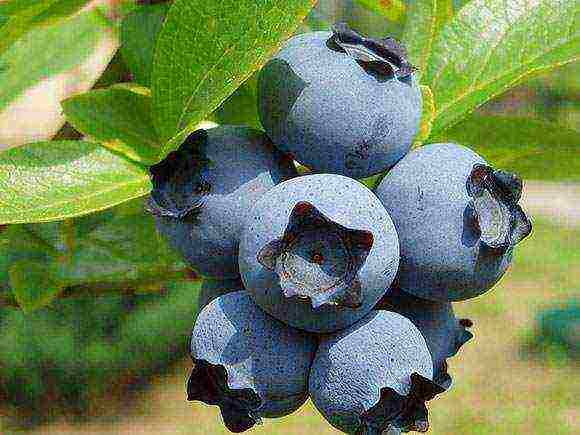
This variety is more modest in size, growing to a height of about 1.8 meters, but compensates for this with its more spreading crown, as well as high growth rates.
Moreover, this bush has red shoots, which, due to their structure, allow the bush to easily endure cold winters, up to -35 degrees, without requiring shelter (if possible, shelter will not damage).
The berries of the bush are large, and reach a diameter of 22 mm, while they have a dense structure that allows them to be transported over long distances without fear of losing their presentation. The berries are light blue, sometimes with shades of blue.
It is due to its large size and light color that this berry is depicted in most types of advertising related to products with added blueberries. The fruit also has an excellent and pronounced sweet taste, but not sugary, the fruit contains a large amount of sugar.
The crop begins to ripen in early August, but it does not ripen evenly, but at intervals of a couple of weeks. Up to 6 kg of berries can be harvested from one bush, which, given their size, is a very impressive result.
Elizabeth's blueberry is one of the most valuable berries in its family, and one of the most persistent. The crown, in comparison with most other blueberry bushes, boasts quite lush foliage. It is necessary to plant a bush in soil containing peat impurities. It is better not to plant the variety in sandy soils, so that it does not lag behind in growth;
Blues
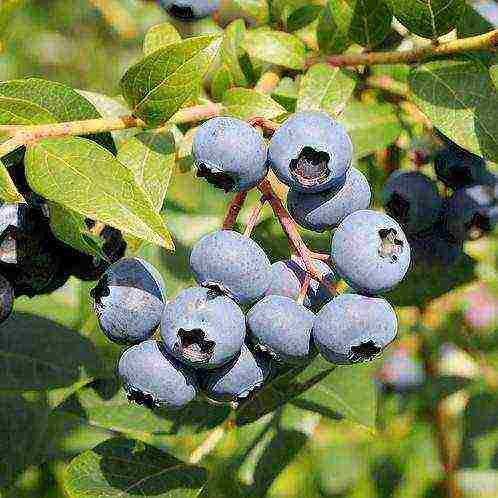
A very unusual and rare variety in the territory of the CIS countries, suitable for growing only in warm and temperate climates, with winters down to -25, or short-term frosts up to -35 degrees.
Despite this, if you managed to get hold of this variety and grow it successfully, you can be sure that you are lucky enough to have one of the most valuable blueberries on the planet. The fact is that the berry of this variety is large for blueberries, allowing it to reach a mass of 4 grams.
The bush begins to bear fruit in mid-July, and brings rather dense and crush-resistant berries, painted in a "deep" blue color, sometimes with shades of blue, and having an excellent sweet taste, according to the assurances of many gardeners, overshadowing all other varieties.
The productivity of the bush is also high, and almost always reaches 6 kg per bush. The variety belongs to tall shrubs, and its standard height reaches 1-8, less often 2 meters. The crown is lush, has leaves slightly larger than those of other blueberry varieties, with a slightly oblong shape;
Aino

A shrub of modest size, the height of which rarely exceeds 90 cm, but this is compensated by the ability of the bush to grow in a horizontal direction, and has a high growth rate.
The variety perfectly tolerates severe winters, the temperature of which can reach -35 degrees. The bush blooms in May or June, and the harvest can be harvested in early August. The fruits are small in size, but at the same time they are distinguished by sweetness and a delicate, subtle aroma.
The color of the fruit is dark blue, most often free from bloom, and in general, compared to other blueberry varieties, is less presentable. The crop matures gradually, over a period of 2 weeks. One bush can be harvested in the order of 7 kg.
The shrub has small leaves of a leathery structure, with a rounded shape, which shine in the sun;
Blue Swede
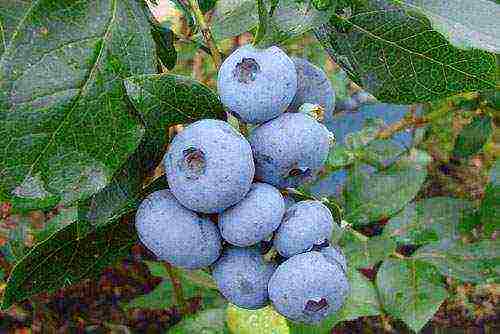
This blueberry variety was developed with an orientation towards widespread cultivation by both amateur gardeners and large companies on an industrial scale. The bush reaches a height of 90 to 150 cm, and has a width of about 100 cm.
The plant tolerates frosts down to -30 degrees. The variety begins to bear fruit quite early, and does this for a long time. So, the harvest begins from the end of June, and continues until July.
The fruit has a sweet taste, generally typical of blueberries. The color of the berries is light purple with a light matte finish. The berries are large in size, and can reach a weight of 3, sometimes 4 grams (not always and not all). The fruits are resistant to physical stress and can be transported without the risk of losing their aesthetic shape.
Berries are used most often for consumption raw, or for making jellies, jams and marmalade. From one bush during the fruiting season, you can collect up to 5-6 kg of fruit.
Fruiting rates can be higher with proper care and abundant feeding. The crown is notable for it, that in the fall its foliage acquires a red color, making the bush very aesthetic. The rest of the crown is unremarkable, and is standard for most blueberry varieties;
Bluecrop
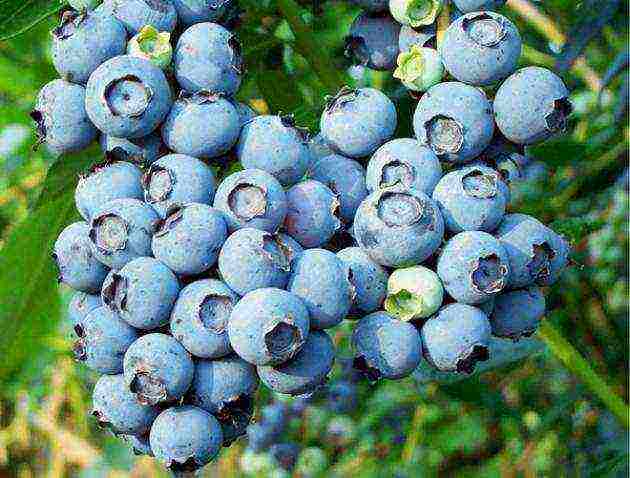
The bush of this variety reaches a height of 180 cm, and has an average growth rate, as well as a modest ability to grow in width. Despite this, this variety requires constant pruning and shaping, since if the bush grows, it will begin to bear small and soft fruits that will not have the proper gastronomic and aesthetic value.
With proper pruning, the fruits reach 20 mm in diameter, and a record 9 or even 10 kg of berries can be harvested from one bush. The fruits have a sweet taste with hints of powdered sugar, are light blue in color, and have a small scar. Fruits begin to ripen in mid-late July, ripening occurs almost simultaneously and evenly.
The crown of the bush has a lush structure, and in the fall, its leaves turn bright red, sometimes even pink and purple, which gives the impression of an unearthly origin of the bush. The frost resistance of the variety is also not satisfactory, and the plant is able to withstand winters down to -30 degrees, without preparation for winter;
Patriot
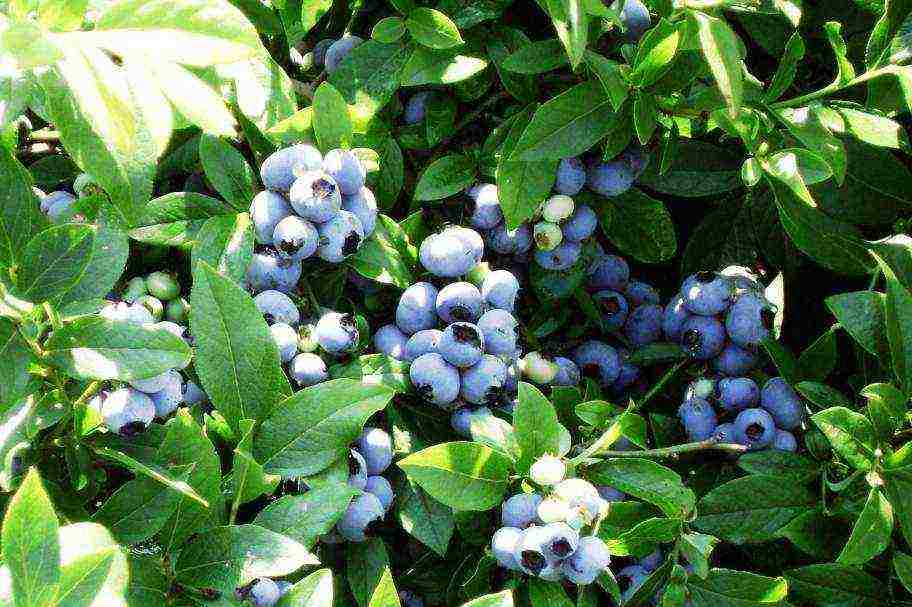
The bush reaches a height of up to 1.8 meters, and has a high growth rate, but at the same time a rather sparse crown. The bush does not tend to grow vertically, and grows straight up. This particular variety is one of the most resistant to diseases among other blueberry varieties.
So, the plant perfectly resists late blight, stem cancer, as well as godroniasis. The fruits begin to ripen around mid-July. The yield is consistently high, and always remains at a minimum at around 7 kg, and with good care it can reach up to 9 kg from one bush.
The fruits themselves are large in size, the diameter of which reaches 19 mm, while their shape is slightly flattened, and has a small and dry scar. The color of the fruit is light blue, the taste is sweet, but the structure of the pulp is somewhat dry, which is a kind of highlight, and only has a positive effect on the taste.
Berries grow in medium and large bunches. The crown is unremarkable and has a standard appearance for most blueberry varieties;
Bonus
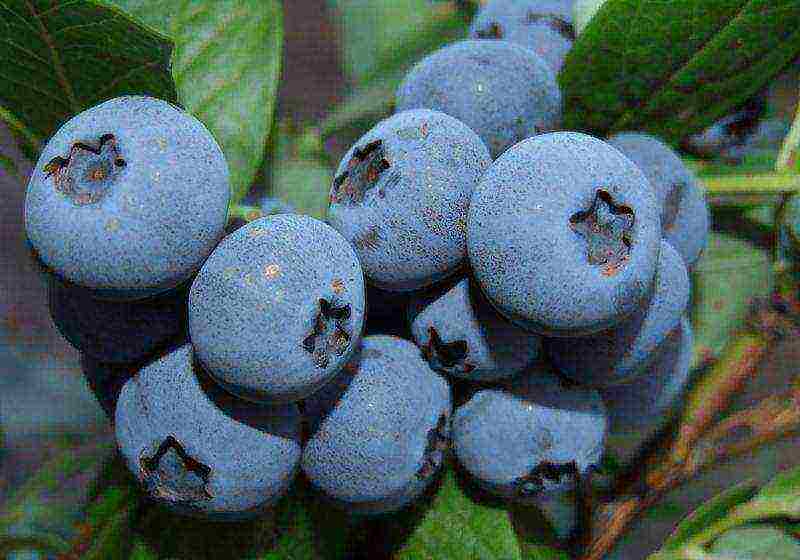
The bush grows up to 1.5 meters high and is not prone to overgrowth. The branches of the bush are vertical, growing upward, without bending to the ground. Under good conditions, the shrub can grow up to 2 meters, but this is usually an exception, not a fact.
The bush tolerates cold winters with temperatures down to -30 degrees, and when covered, it can withstand frosts down to -35 degrees or more, for a long time. The bush begins to bloom in the middle and even late spring, which is a great advantage, because this way the variety protects itself from the risk of frostbite on its buds during the early spring frosts.
Collecting the same fruits begins in July, and the fruits themselves, even after full ripening, do not fall off, and stay on the branches for about 10 more days. The berries are large in size, the diameter of which reaches 20-25 mm, and this is only an average indicator, there are also more.
The skin of the berry has a light blue color and elastic structure. The berry itself is resistant to damage and tolerates transportation well. The berry has a rather sweet taste, sometimes even slightly sugary, which is why it is best consumed raw or frozen.
Ripening occurs approximately simultaneously, and from one bush you can get about 5 kg of berries. The crown of this shrub has a decorative appearance, with large and rather lush leaves, as well as large clusters of large fruits. The foliage also turns red in the fall;
Jorma

This variety has bushes up to 1.2 meters high, and is prone to overgrowth, which means it must be cut and shaped every season. The growth rate of the bush is high, and besides the fact that it tends to grow horizontally, it grows well upward.
The frost resistance of this variety is beyond praise, since the plant tolerates frost at -35 degrees for a long time, and short-term frosts up to -39 degrees. The fruits are large in size, up to 18 mm in diameter, light blue, sometimes with shades of purple, as well as sweet-sour taste, and abundant anthocyanin content.
The fruits of this variety are suitable for making preserves, jams and berry fillings. Also, this variety has found its application in the creation of medicines and dietary supplements.
Harvesting begins in early August and lasts until the end. The variety is picky about the soil, and it is recommended to plant it in acidic soils in order to fully reveal its potential. The crown of the shrub is notable for its large leaves with a rich green color;
Northland
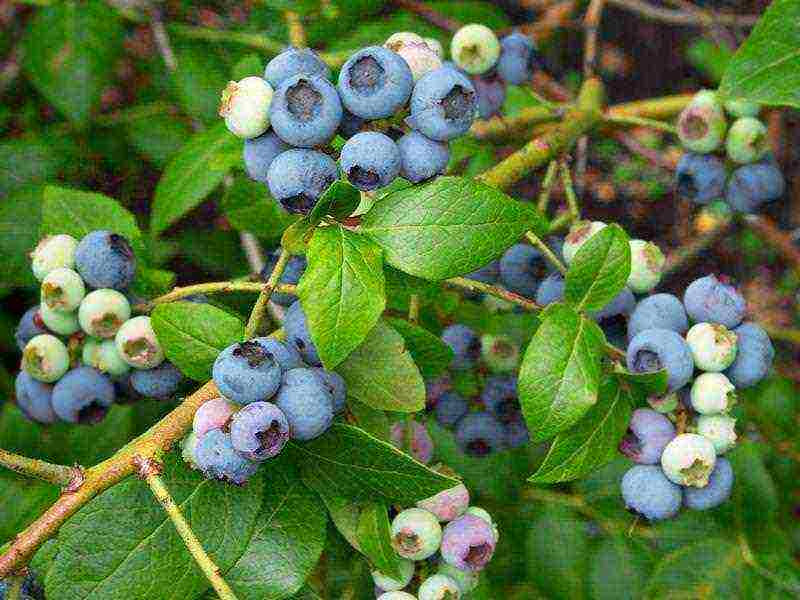
The variety has a rather low bush, the height of which rarely exceeds 1 meter, but this is compensated by the fact that the bush has a spreading shape, grows well, and does not require frequent shaping. Frost resistance is also high, withstands winters down to -30 degrees.
Separately, it is worth mentioning the yield, which can reach 8 kg from one bush, and this is a good indicator for a low-growing bush. The fruits are of medium size, and usually reach a weight of 1-1.5 grams, have a sweet taste, are light blue with a slight bluish bloom, have a dense structure, and are easy to transport.
Harvesting begins in mid-July. The crown is notable for its small leaves with a rich green color, as well as year-round green shoots. This means that although the variety can withstand frosts down to -30 degrees, if such are expected for more than a month, it will not damage the shelter of the bush before the onset of heat.
The most popular early varieties
If you are interested exclusively in early blueberry varieties that are suitable for growing in the middle climatic zone, and which will bear fruit from the second half of July, in addition to the samples presented above, pay attention to the following names:
- Rankocas;
- River;
- Sunrise;
- Puru;
- Duke;
- Erliblu.
Most popular late varieties
If you are looking for a late blueberry that starts bearing fruit in the second half of August, take a look at one of the following:
- Nelson;
- Spartan;
- Darrow;
- Toro;
- Jersey;
- Rubel;
- Covill;
- Berkeley.
Conclusion
As can be seen from the description, the overwhelming number of blueberry varieties suitable for our conditions have similar characteristics, almost the same frost resistance, minor differences in the taste and visual qualities of both the crown and the berries themselves.
In more detail, the significant differences between varieties affect the following points:
- Growing soil.
- Reproduction methods.
- Pruning methods.
- Feeding and fertilization methods.
- Disease susceptibility.
For more information on such differences between varieties, expect in the following articles, since the topic is very extensive and has a lot of information.
Based on today's text, we can make an affirmative conclusion that the best blueberry varieties for the middle lane are tall varieties focused on growing in regions with harsh winters, which allows you to get rid of the need for regular pruning, the need to cover the plant in winter, and will help you get more large and plentiful harvest.
You can also expect a more detailed description of blueberry varieties in the following articles!
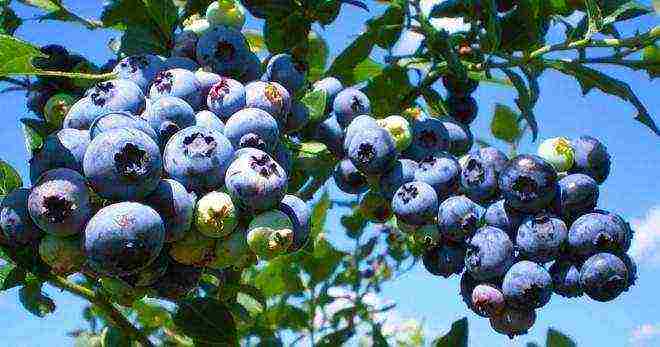
The well-known garden blueberry, whose varieties have dozens of varieties, differing in bush height, ripening time, yield, is a beautiful and useful plant. By planting it on your site, you can get a bright hedge, which, moreover, will delight with sweet and sour gray fruits with a lot of healing and useful properties.
Garden blueberry - description
The dark blue, whitish-coated berries have many beneficial properties. They contain a lot of vitamins and minerals, antioxidants. They have a beneficial effect on the cardiovascular and nervous system, metabolism, and improve vision. The fruits are useful for hypertension, atherosclerosis, rheumatism, and reduce the risk of developing cancerous tumors.
The garden plant blueberry is a highly branched shrub, the height, depending on the variety, ranges from 40 cm to 3 m. In summer, its stems are abundantly covered with pale blue clusters with large and fleshy berries. The advantage of the culture is its resistance to pests and diseases. The plant has a lifespan similar to that of fruit trees. The main characteristic of growing a crop is adherence to acidic soils with a pH of 3-5. The bush is accepted to bear fruit in the fourth year of life, depending on the species, a collection of 1.5 to 10 kg is obtained from the specimen.
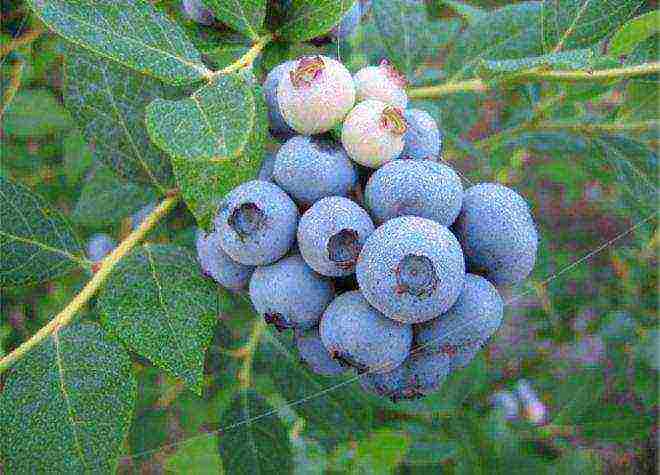
The best varieties of blueberries
In garden blueberries, varieties differ in the appearance of the branches, resistance to cold weather, and the period of fruit collection. Varieties of culture by ripening time are distinguished:
- early varieties of garden blueberry - will delight you with the harvest in the middle of the summer season;
- mid-ripening - ripen by the end of July;
- late garden blueberries, varieties yield in late August - early September.
By the size of the shoots, plants are divided into:
- undersized, have a height of up to 1 m, productivity 1.5 - 2.5 kg.
- tall blueberry varieties, their branches reach 3 m, productivity - up to 10 kg.
When choosing a culture, the real conditions of the local climate are taken into account. The best varieties of garden blueberries for the middle lane are tall ones (for example, Patriot, Blyukrop). They give a rich harvest, firmly endure negative phenomena, berries are suitable for long-term storage, which is important for determining the rationality of growing a crop. For northern latitudes, undersized garden blueberries are relevant - varieties Divnaya, Northblue. The height of the branches helps them to easily survive the winter under the dense snow layer.
Blueberry Blue - variety description
Garden blueberry of an early variety, with practically no drawbacks. She has a powerful tall bush with decorative characteristics - in the summer it will decorate the garden with greenery and blue bunches, in the fall - with yellow foliage, at the end of September - with bright crimson. The variety is popular for commercial cultivation and is used in small and medium-sized agribusiness. Garden blueberry Blueberry - features:
- has a shoot size of 1.5-2 m;
- shrub blooms in mid-May, ripens in July - early August;
- Blues are resistant to diseases, damage to branches, mummification of fruits;
- berries are light blue with a solid wax layer, weighing up to 2.2 g and a diameter of 18-22 mm;
- they do not crack, are suitable for machine cleaning, last a long time and are well transported;
- productivity - 3.6 - 6 kg per copy;
- the plant is frost-resistant, tolerates cold up to -32 ° C, winters with mulching.

Northblue blueberries - variety description
Winter-hardy low-growing garden blueberry, varieties are acceptable for northern regions, where the fertility of tall shrubs is reduced due to harsh conditions. Its berries are stored for a long time and are recommended for fresh consumption and for industrial preservation. Northblue soda blueberries - features:
- undersized genus, reaches a height of 0.6-0.9 m;
- the berry is noticeable (15-18 mm in diameter), dark gray, taut, with a small scar and good taste;
- the fruit ripens in early August;
- the collection for a low-grade species is large - 1.5-2.5 kg per specimen;
- bush blueberry garden Northblu has a decorative look and is used in landscape design;
- seedlings are characterized by extreme frost resistance, withstand cold up to -42 ° С;
- not very picky about the composition of the soil.
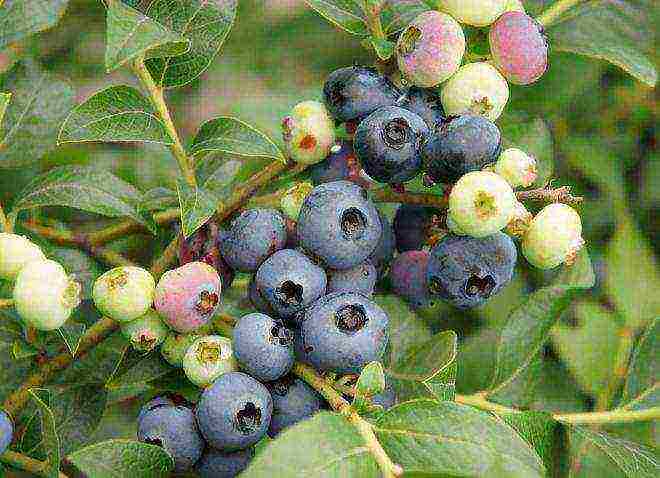
Blueberry Chippeva - variety description
Winter-hardy undersized crop with an early ripening time. The plant is prized in cold areas. Garden blueberry, Chippeva variety - description:
- the shrub stands out in a spherical shape with upward shoots, compact, reaches a height of 1.25 m;
- fruits have light blue skin, large size (17-20 mm), firm, odorous. When fully ripe, they are very sweet;
- a low bush will give a harvest in the first half of July;
- the yield of an adult specimen is 2.5-6 kg;
- prefers bright places, abundantly drained, acidic soils.
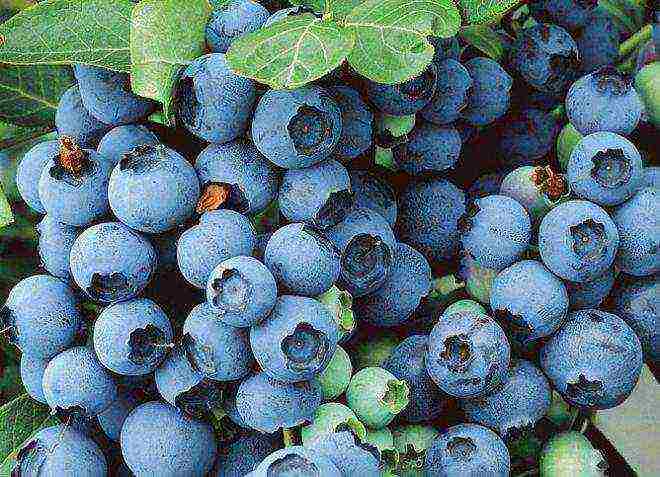
Blueberry Divnaya - description of the variety
The culture is of medium ripening, with a high degree of winter hardiness. The advantage of the plant is that it is less susceptible to disease. Medium blueberry, Divnaya grade - description:
- has shoots up to 1.8 m high, spreading, heaping;
- branches grow magnificently, the disadvantages include the fact that they require annual pruning;
- berries of medium size, slightly flattened, sweet and sour, weight 0.6 g;
- the skin of the fruit is thin, can crack, so they are not suitable for transportation and long-term storage;
- yield - 1.6 kg per specimen.
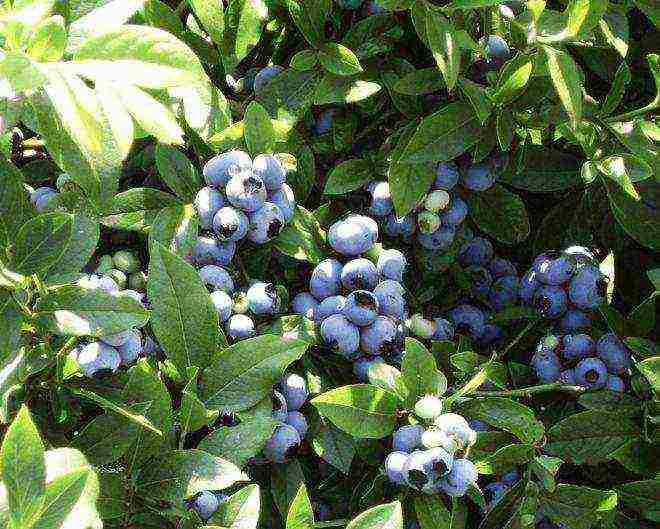
Blueberry Nelson - variety description
A well-known variety that has good taste. Nelson belongs to the early maturing species. Its value lies in the fact that a dense and large fruit pleases with a late harvest, and for its frost resistance and high adaptation to the climate, seedlings are loved by both farmers and amateur gardeners. Garden blueberry Nelson - description:
- the bush reaches a height of 1.6 m, spreading, wide;
- the berries are impressive, have the shape of an oblate ball, up to 20 mm in diameter. They are distinguished by a sweet wine taste and strong aroma, light blue color and jelly green flesh;
- The fruits have a strong skin, are suitable for long-term storage, and are transported without problems;
- Nelson's productivity reaches 6 kg per specimen, the harvest ripens at the end of August.
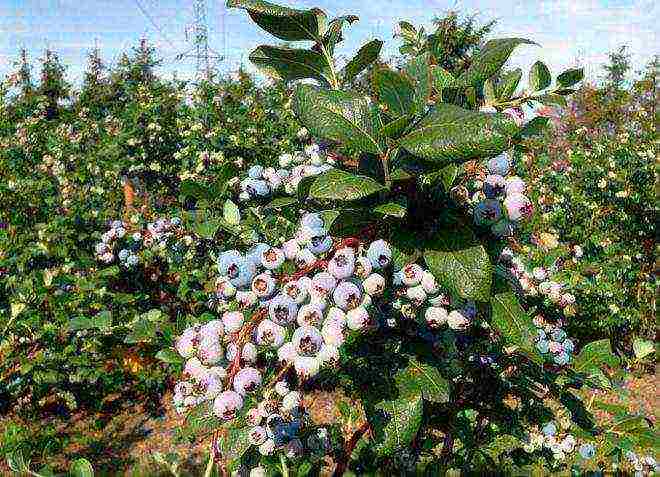
Blueberry variety Bluecrop
A tall shrub, characterized by non-simultaneous ripening, which begins in mid-July and ends before the end of August. Blueberry is one of the most productive blueberry varieties, it is considered one of the best, suitable for commercial and amateur cultivation. According to the opinions of gardeners, this culture is the standard of the species. Its advantages are frost resistance, absence of diseases and drought resistance. Features of the Bluecrop species:
- the bush reaches a size of 2 m, the shoots are directed upward;
- the seedling bears fruit in long clusters with large blue berries, up to 20 mm in diameter. Such blueberries in the garden need to be pruned annually;
- will give birth to a bush abundantly, the fruits are firm and very tasty. They are suitable for freezing and eating raw;
- one specimen yields up to 9 kg.
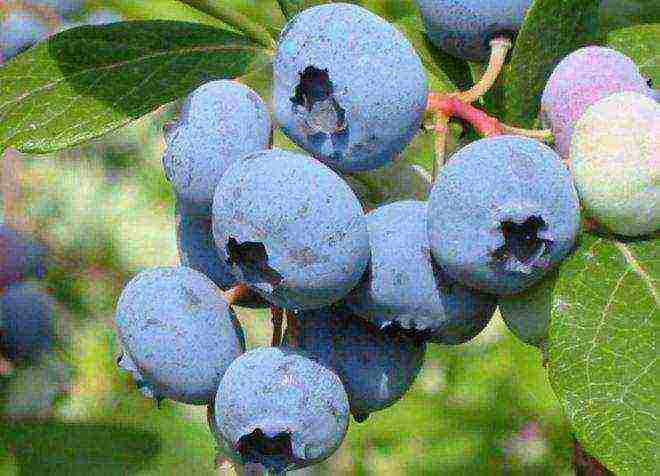
Garden blueberry Patriot
This variety of medium ripeness is known to many lovers of tall breeds, the harvest of fruits falls on the end of July. The culture pleases with high yield and decorativeness. The shrub has a peculiarity - in the process of ripening, the berries change color from green to red, and at full maturity they become dark blue. Blueberry, variety Patriot - features:
- high bush, up to 2 m in size;
- the stems have a rectilinear shape, therefore, planting on the site can be done densely;
- berries are light blue, large, up to 19 mm in diameter, gather in bunches on the branches;
- the skin of the fruit is elastic, they tolerate transportation and storage well;
- record yield - up to 9 kg, the plant is often grown on an industrial scale.
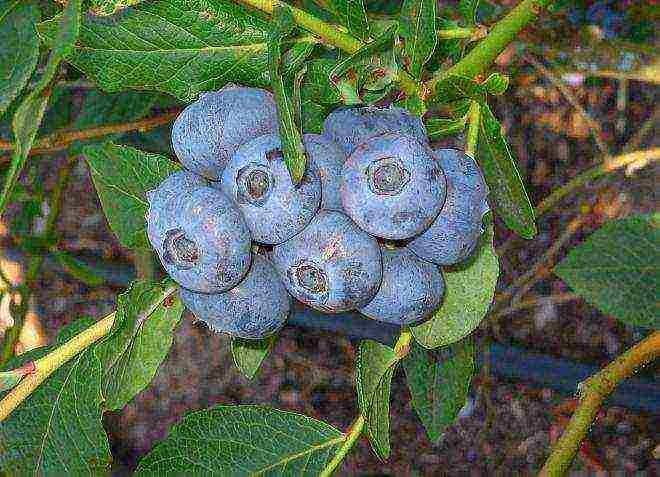
Garden Blueberry Duke
An early variety of culture, it will delight you with a ripe harvest already in the second half of July. Produces large and sweet bunches, Duke is considered the most suitable for consumption raw. Crop-laden branches are tied up during the ripening period so that they do not break off. The disadvantage of the plant is the demand for soil moisture, it should not be high. Duke blueberry variety - features:
- the size of the bushes is up to 1.8 m, the shoots are straight, not very branching;
- the crop is distinguished by late flowering, which minimizes the risk of damage as a result of spring frosts;
- berries are burly, up to 2 cm in diameter, juicy, sweet;
- fruits tolerate transportation well, are suitable for freezing;
- the yield reaches 8 kg per specimen.
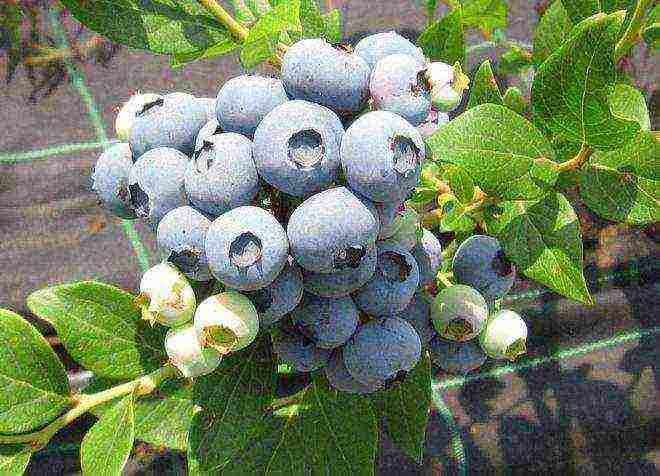
Blueberry variety Bonus
One of the largest berries, it ripens late. The fruits beckon with their gigantic size - up to 3 cm in diameter; they begin to ripen in early August. Garden blueberry Bonus - features:
- shoots reach a size of 1.5 m, spreading;
- berries are very large, dense, with a small scar, have a sweet taste, suitable for long-term storage and transportation;
- the plant is highly winter-hardy and suitable for regions with a harsh climate;
- productivity reaches 5 kg per copy;

Blueberry variety Bluegold
Early berries, they acquire a rich color at the beginning of summer, and ripen in mid-July. Even in the most lean years, up to 4.5 kg are harvested from one shrub. The weak side of Bluegold is that the fruits quickly wither and mummify. In addition, they crumble when overripe, so the crop must be harvested on time. Garden blueberry Bluegold - features:
- spreading bush, powerful, up to 1.5 m high. A lush plant in itself is an adornment of any garden. But due to the spreading nature, the culture requires regular pruning;
- berries reach 18 mm, dense, perfectly stored and transported;
- maximum yield - 7 kg;
- the culture can withstand frosts down to -35 ° С, it is acceptable for the northern regions.
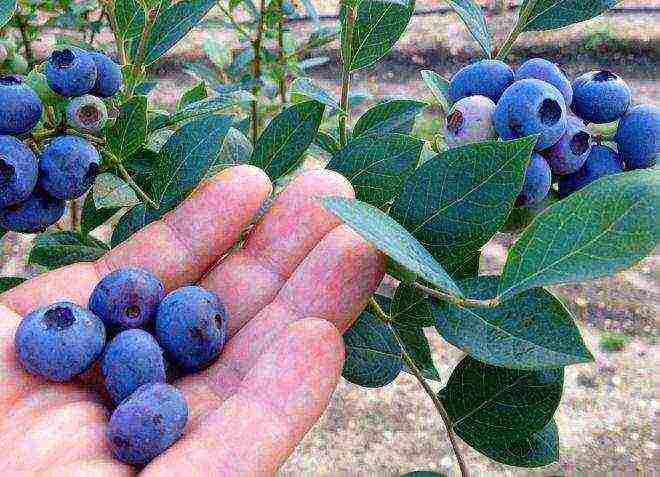
Elizabeth blueberry variety
Elizabeth's garden berry is considered a favorite in taste and smell. Her fruits are noticeable and smell delicious, ripen gradually - within two weeks. They delight with the harvest at the end of August. When asked which varieties of blueberries are the most valuable, summer residents always cite Elizabeth as the best late species in terms of taste. Although some of its harvest may not have time to ripen, fertility is up to 4-6 kg per specimen. Elizabeth is a popular garden blueberry, features of the variety:
- straight bush, up to 1.8 m in size;
- berries are impressive up to 22 mm in diameter, strong, easily torn off and almost not deformed during transportation;
- aromatic and sugar fruits;
- dignity of Elizabeth - ease of cultivation by cuttings;
- the bush does not develop well in a sandy substrate.
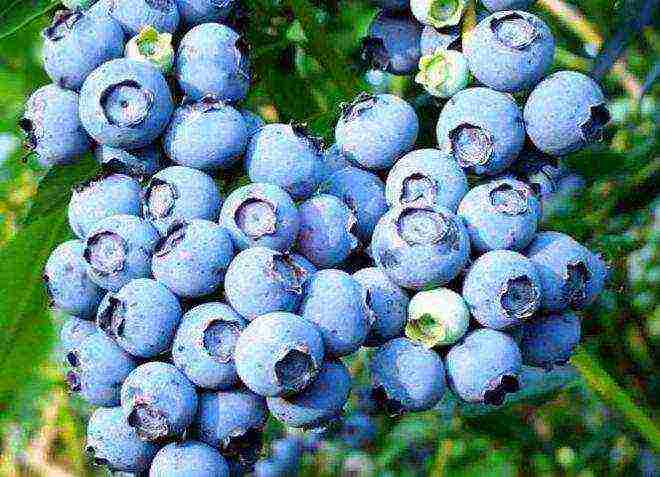
Blueberry Chandler - variety description
Late tall shrub, harvested in September. It grows well in regions with a temperate climate and not very cool winters.Its special attraction is its considerable berries, the most massive of all relatives, their diameter is 2-3 cm, weight is 2 g. Chandler's features:
- the bush has a size of 1.7 m, powerful, fast-growing shoots;
- the berries are impressive, delicate, not transported too successfully. They are recommended for fresh consumption. Because of this, Chandler is not very popular for commercial production;
- productivity is up to 5 kg per specimen, the collection is stretched for 4-6 weeks;
- such blueberries in the garden area require abundant feeding, it is advisable to collect it by hand.
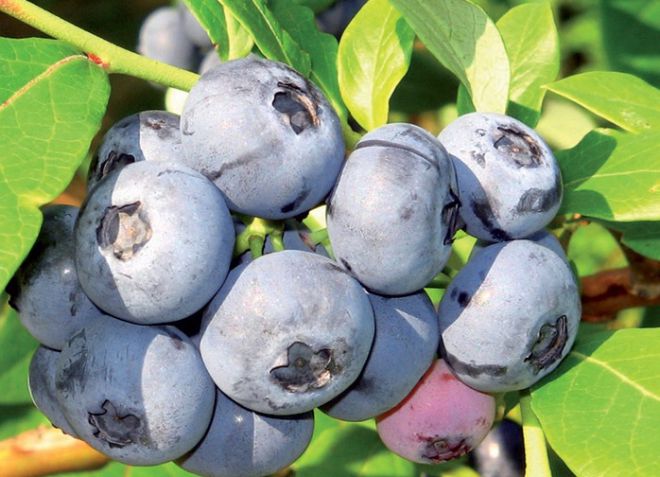
Description of the best 44 varieties of blueberries

Blueberries are a culture unfamiliar to Russian gardeners, the interest in which is increasing every year. It is a relatively thermophilic crop that requires careful selection of the variety.adapted to the climatic conditions of the landing region. This article provides an overview and description of the best blueberry varieties in different categories - Bluecrop, Thoreau, Duke, Spartan and others.
Table of contents
- Varieties of garden tall blueberry
- Description of varieties of undersized blueberry
- The best blueberry varieties for the Moscow region: Erliblu, Nelson, Spartan and others
At the beginning of the 20th century, Brucke was selected from a wild blueberry species. Subsequently the Russell variety was developed from undersized blueberries, which is distinguished by frost resistance and early maturity.
After crossing these varieties, biologists obtained excellent results, and after adding southern blueberries to them, four valuable varieties were developed. So a new culture entered gardening - tall blueberries.
Today there are about 50 registered varieties in the United States.
Tall blueberry - a branched shrub with a height of 1.2 to 2.5 m. The plant is distinguished by its rapid growth and good shoot-forming ability. The size of the fruits depends on the variety, often reaching up to 4 g. The taste of the berries is characteristic of the species, but sweeter than that of wild forms.
New varieties of tall blueberries are quite winter-hardy and frost-hardy, can withstand temperatures as low as -30 ° С... At lower temperatures, they can freeze, but with proper care they quickly recover. Spring frosts are more dangerous for loss of yield, blueberry flowers do not tolerate a drop in temperature of more than -2 ° C.
Early varieties: Reka, Duke, Patriot and others
Fruits of early varieties of culture in the middle lane begin to ripen from the second half of July.
The best varieties:
- Rankocas;
- River;
- Sunrise;
- Puru;
- Duke;
- Patriot;
- Blues;
- Erliblu.
Early tall blueberry Erliblu Early tall blueberry Puru Early tall blueberry Rankocas Early tall blueberry River Early tall blueberry Sunrise Early tall blueberry Duke Early tall blueberry Patriot
Extraordinary taste of fruits and high yield (8-18 kg per bush) differs grade River.
Duke grade very popular in America. Plant feature - late flowering, which excludes loss of yield due to damage to flowers by spring frosts. Despite this, the fruits ripen by mid-July. The shrubs of this variety have strong fruits with a dessert taste and a pronounced aroma.
Feature of the Patriot variety plasticity to soil conditions, resistance to late blight. Therefore, growing plants of this variety does not bring additional trouble to the gardener.
Many gardeners plant blueberry varieties with different ripening times in their garden. This allows for a continuous harvest from July to mid-September.
Shrub fruits of these varieties begin to ripen in the first half of August.
The best varieties:
- Berkeley;
- Covill;
- Bluecrop;
- Hardible;
- Rubel;
- Bonus;
- Jersey;
- Toro;
- Darrow;
- Spartan;
- Elizabeth;
- Nelson.
Late tall blueberries Berkeley Late tall blueberries Bluecrop Late tall blueberries Bonus Late tall blueberries Covill Late tall blueberries Nelson Late tall blueberries Spartan Late tall blueberries Toro Latetall blueberry Jardible
Jersey variety one of the best pollinators, this should be taken into account when selecting shrubs for a combination planting. In addition, it is resistant to late spring frosts and viral diseases. This is an old and proven variety by many gardeners.
Bluecrop the most reliable, consistently fruiting variety. Productivity 6-9 kg per bush... The fruits of this shrub are valued for their high transportability and resistance to natural disasters. The Toro variety is highly frost-resistant, can withstand temperatures as low as -34 ° C.
A real find for lovers of eating fresh fruits is grade Bonus... This plant fruit diameter reaches up to 30 mm... The pulp is sweet and firm, so the fruit is able to withstand long-term transportation.
All varieties of tall blueberry presented in this review are suitable for cultivation in the southern and middle horticultural regions. When choosing a variety for a garden plot, it is important to pay attention to the characteristics of the plant, winter hardiness and disease resistance.
The introduction of low-growing blueberry species into crops began in the 1930s, in parallel with tall species. The most promising forms were selected from wild species and breeding work was carried out.
As a result varieties of undersized blueberry with a shorter growing season and higher frost resistance were bredthan varieties of tall crop species.
Also, blueberry varieties obtained by selection from the natural population have been introduced into horticulture.
Depending on the variety, undersized blueberry shrubs reach a height of 50 cm to 1.2 m. The yield ranges from 1.2 to 2.5 kg, but there are exceptions.
Medium-sized fruits from 1 to 1.8 cm in diameter with a pronounced sweet and sour taste, perfect for culinary preparations.
The relatively high frost resistance makes it possible to successfully cultivate all varieties of undersized blueberries in the middle and northern regions of horticulture.
Early blueberry varieties begin to ripen in mid-July.
Recommended varieties:
- Northland;
- Northky;
- St. Cloud;
- Northcountry;
- Bluegold;
- Northblue;
- Chippewa.
Northblue early low blueberry Northland low low blueberry Chippewa early low blueberry Bluegold early low blueberry
According to gardeners grade Northland can withstand downgrade temperatures up to -40 ° С... Therefore, it can be planted in regions with harsh winters. Plants of this variety are distinguished by a regular yield (4-8 kg per bush), which is rare for low-growing varieties.
St. Cloud the earliest variety, the fruits of the bush begin to ripen in early July. A distinctive feature is the need for annual pruning. Bluegold variety valued for its stable yield (4.5-7 kg per bush), winter hardiness and resistance to fungal diseases.
Mid-late varieties: Emil, Polaris, Putte
The fruits of these varieties of plants begin to ripen from the beginning of August.
The best varieties:
Bush of medium-late low-growing blueberry Emil medium-late low-growing blueberry Polaris Medium-late low-growing blueberry Putte
Feature of the Putte variety - self-fertility, it can be planted in single plantings.Polaris variety prized for consistent yields 1.5-2 kg from the bush. Fruits of the Emil variety sweeter, ideal for making preserves and jams.
All varieties of low-growing blueberries are compact and highly decorative, therefore they are often used in landscape design. Plants can be used to cover unsightly buildings, form a hedge, or decorate a spacious lawn.
These varieties were introduced into cultivation by selecting promising forms of marsh blueberry. They are distinguished by high winter hardiness and frost resistance, they are recommended for cultivation in the Urals and Siberia. Blueberry bushes of these varieties able to withstand temperature drops from -35 ° С to -43 ° С.
Varieties:
- Taiga beauty;
- Marvelous;
- Shegarskaya;
- Blue scattering;
- Yurkovskaya;
- Graceful;
- Nectar.
Swamp blueberry Nectar Swamp blueberry Shegarskaya Swamp blueberry Yurkovskaya
Among these plants, gardeners especially highlight grade Taiga beautyable to withstand a drop in temperature down to -43 ° С.
In addition, the variety is resistant to viral and fungal diseases. High yields are distinguished by varieties Divnaya and Golubaya scattering — 1.6 kg per bush.
Have Shegarskaya varieties large (1.1 g) and juicy fruits.
The climate in the Moscow region is moderately continental with a pronounced seasonality. The average temperature in winter is -11 ° С, during the influence of the anticyclone it can drop to -25 ° -30 ° С.
The soil freezes up to 65-75 cm, and the height of the snow cover reaches 35-45 cm. Together, these conditions are suitable for growing blueberries.
The only danger for blueberries is spring and autumn frosts, the possibility of which must be taken into account when choosing a variety and caring for it.
The best varieties:
- Patriot;
- Bluecorp;
- Rankocas;
- River;
- Bluegold;
- Blue Ray;
- Spartan;
- Puru;
- Erliblu;
- Nelson.
Blueberry Bluecrop Blueberry Blueberry
Variety Patriot actively cultivated by gardeners of the Moscow region. Among the positive characteristics, stable yield 5-7 kg per bush, resistance to root and stem rot. In addition, plants of this variety are highly decorative and are often used in the formation of hedges.
Rankocas variety an excellent option for early harvesting, the fruits of these shrubs begin to ripen in the first decade of July. The originators claim that the plants able to withstand frosts down to -34 ° С.
Fruits of the Spartan variety are an excellent option for fresh consumption. These are berries with light acidity, which keep their shape well and tolerate long-term storage. The Erliblu variety is distinguished by its high winter hardiness, easily tolerates possible temperature drops and the influence of return frosts.
All varieties of undersized and marsh blueberries are suitable for growing in the Moscow region. They are less productive, but more plastic to climatic and soil conditions, are resistant to many diseases.
The basis for successful blueberry cultivation is the correct selection of the variety. This is a rather whimsical plant that requires careful adherence to all the rules of agricultural technology..
Despite this, many gardeners have already abandoned their usual berry crops, gradually equipping small blueberry plantations on their plots.
This is facilitated by the high nutritional value of the fruits of the culture and the increased demand in the market.
Blueberry varieties, comparative characteristics of their qualities and properties
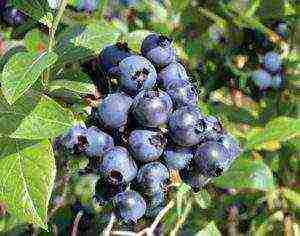
When planning a garden, the question arises: which varieties of blueberries to choose? Blueberries are one of the most popular forest berries. Its beneficial medicinal properties and perfect taste have long been loved by humans. And, of course, not a single gardener has already thought about growing this berry crop in a garden plot.
Garden blueberry is a relatively young crop. This extremely beautiful plant will ennoble any garden. For example, tall varieties can serve as hedges, which are actively used in landscape design. At the same time, the berry bush, with proper care, will always delight its owner with a vitamin harvest.
Taste qualities of garden blueberry varieties
There is an opinion among ordinary people that garden blueberries are much inferior to forest blueberries in taste and useful properties. And this is a huge delusion! Rest assured that the taste of garden blueberries will never cease to delight you.
Be sure to plant this juicy berry in your garden! To prove its usefulness, many studies have been carried out, which have shown that in their chemical composition, garden blueberries are no different from forest blueberries.
This means that it contains all the beneficial properties of wild berries.
back to content ↑
Harvest varieties of garden blueberries
Garden blueberries are much more fertile than forest blueberries. A wild shrub begins to bear fruit only after a fifteen-year growth period. Unlike forest brethren, garden varieties give a harvest already in the second year after planting, which is a clear advantage for lovers of delicacies.
The most productive varieties of garden blueberry will amaze you with their fertility! With just one harvest, you will never want to pick berries in the forest again.
For example, from one bush of the Canadian Blue Crop variety, you can get about ten kilograms of large and fleshy blueberries, not to mention the fact that this variety bears fruit even in extreme conditions!
When choosing a variety of garden blueberries, you should pay attention to the size of the shrub if you want the maximum yield from your berry. Naturally, tall varieties give many times more blueberries than their undersized counterparts.
back to content ↑
Blueberries of the best varieties for the garden and summer cottages
How to figure it out and find the "best"? In order not to be mistaken in this matter, you should buy seedlings directly from nurseries, where agronomists diligently monitor the quality of reproduction of this whimsical culture.
Thanks to the diligence of breeders, the best varieties of blueberries for the garden and summer cottages were bred. As a result, we have the opportunity to choose among a huge variety of blueberry varieties, different in their qualities and characteristics.
The title of "the best blueberry varieties for berry growers" rightfully belongs to the Canadian "Blue Crop", "Blue Ray" and "Duke". Such varieties as "Darrow" and "Rankokas" are not lagging behind them.
back to content ↑
Blueberry varieties by maturity
In most cases, the ripening period for blueberries is extremely important for the gardener. And therefore, when choosing seedlings for your berry, this is one of the main criteria.
Blueberry varieties are divided into three groups according to the ripening period: early, middle and late.
At the same time, each species has its own advantages and disadvantages, which will help gardeners to analyze all the characteristics and characteristics of varieties.
back to content ↑
The best early ripening blueberry varieties
The fruiting period is early July.
Variety "Blue Gold" has a height of up to one and a half meters. The yield is good, an average of six kilograms per bush. Fruits are light blue in color, of medium size. The berries are quite dense and have a rich taste.
Variety "Duke" has a bush up to 1.8 meters high. The variety is frost-resistant and does not tolerate waterlogging of the soil. The yield of this variety is good, up to nine kilograms per bush. Berries have a satisfactory taste, which improves markedly when cooled. The fruits are poorly stored and do not tolerate transportation well.
Variety "River" can grow up to two meters in height. The bush is erect and strong. One blueberry bush of this variety can produce up to ten kilograms of berries! The fruits reach one and a half centimeters in diameter and have a bright blue color. The berries are of excellent quality, spicy in taste and quite aromatic. They do not crumble when ripe and are suitable for transportation.
"Stanley" variety it can also grow up to two meters. But his yield is less, up to five kilograms per bush. The fruits are poorly stored. Moreover, the berries are quite dense, large and have a pleasant dessert taste.
Shrub variety "Earley Blue" reaches 1.8 meters and has high frost resistance. The yield is good, up to seven kilograms per bush. However, the berries are quite small and have only a satisfactory taste.
back to content ↑
The best mid-season blueberry varieties
Fruiting period - late July, early August.
Blue Jay variety one of the fastest growing and most powerful blueberry bush reaches up to 1.8 meters. The yield is good, up to six kilograms per bush. The berries have a very pleasant taste, are quite dense, and therefore they are stored for a long time and are suitable for transportation.
Variety "Blue Crop" is one of the most demanded on the market. The height of the shrub reaches two meters.The fruits reach up to one and a half centimeters in diameter.
Strong, high quality berries have a pleasant taste and aroma. The yield is good, up to 9 kilograms per bush. The ripening period is extended.
The variety is extremely drought-resistant, able to grow and bear fruit even in the most extreme conditions. At the same time it is resistant to diseases and pests.
Blue Ray variety has also established itself as one of the best. The bush is erect and reaches 1.8 meters in height. The fruits are glossy and large enough. The ripening period of the fruit is extended. The yield is good, up to eight kilograms. The taste of the fruits of this variety is quite specific, for an amateur.
Variety "Toro" reaches two meters in height. Winter hardy. The yield is good, up to nine kilograms per bush. The berry has a medium-sized taste, pleasant and very sweet.
Variety "Covill" reaches a height of two meters. The variety adapts to any environmental conditions. The yield is good, up to six kilograms per bush. The fruits are large, up to one and a half centimeters, and have a sour, but pleasant taste.
Variety "Nelson" reaches 1.6 meters in height. The bush is quite dense. Can withstand frosts up to 34 degrees! The crop is regular and high, up to nine kilograms per bush. The berries are large and dense, can reach two centimeters in diameter. The taste is sweet with a spicy aroma.
Sorts "North Blue" and "North Country" both are undersized, up to one meter in height. Winter hardy. The yield is average, up to 2.5 kilograms of fruit per bush. Large berries. The taste of the fruit is pleasant and sweet. The fruits of these varieties keep very well.
Variety "Elizabeth" reaches two meters in height. Heat-loving. The yield is good, up to six kilograms per bush. The fruits are large, firm, persistent and very aromatic.
back to content ↑
The best late ripe blueberry varieties
The fruiting period is the end of August, September.
Blueberry variety "Herbert" has a powerful and widely spreading bush that reaches over two meters. The yield is high, up to four kilograms per bush. The fruits are large and tender, sweet-tasting and incredibly aromatic.
Jersey variety also reaches a height of two meters. This variety is characterized by high winter hardiness. The yield is high, up to six kilograms per bush. The berries are not large enough, but dense and even elastic. The taste is good.
Dense bush of the "Rankokas" variety reaches 1.8 meters in height and is prone to thickening. Therefore, it requires annual brightening pruning. Frost-resistant and unpretentious. The yield is good, up to six kilograms per bush. The berries are not large, but very sweet.
There are many more varieties of blueberries that you can ask the nursery's agronomists about, and then buy yourself the one that is right for you!
Top 10 American Blueberries
Many varieties are available for sale American blueberry... They differ among themselves in height, ripening period and the purpose of the fruit. The article presents 10 of the best varieties of American blueberries for amateur cultivation in a personal plot.
Description
Most of 450 varieties blueberrycalled American blueberry or garden blueberry (Latin Vaccinium corymbosum) was bred in America. More than 30 of them can be bought in our garden centers.
They differ in morphological features - i.e. cut, vigor, ripening time, shape and color of leaves, size, appearance of fruits, taste, yield, resistance to diseases and frost.
Unfortunately, not all of them are suitable for hobbyist cultivation, many of them are intended for industrial cultivation.
Blueberry bushes should be purchased from proven garden centers. The largest part of the seedlings appears in spring (March) and autumn (September) - these are, as a rule, 2-3 year old bushes growing in pots with shoots 30-40 cm in height (they are perfectly accepted and begin to bear fruit the next year).
Cross-pollination - is pollination necessary?
Most varieties of American blueberry are self-pollinating, but we will get higher yields as a result of cross-pollination of different varieties, so it is worth planting a couple of blueberry varieties at once. In addition, planting several varieties will extend the harvest period by a couple of months.
What varieties of American blueberries to choose?
The most common division of varieties is the ripening time - varieties can be divided into early, mid-early and late varieties.
Varieties blueberry (American) tall bloom from the second half of May to June, and bear fruit from early July to late September. Harvesting (from one variety) usually lasts from 2 to 4 weeks.
The fruits ripen unevenly, so you have to harvest the crop several times. From one bush, you can collect from 3 to 10 kg of berries.
Early varieties of American blueberry:
- ‘Bluetta’ - medium vigor, characterized by a close cut. The berries form small clusters, ripen very early - already in the first half of July. The berries are medium-sized, spherical, blue, with a light waxy coating, tasty and aromatic. Little prone to freezing.
- 'Earliblue' - with moderately strong growth, grows up to 1.5 m in height. The cut is spacious, upright, the shoots are tight. The berries are medium, spherical, tasty and aromatic, form clusters, ripen in early July (begins to bear fruit two weeks earlier ‘Bluecrop’), the yield is moderate. The variety is valued for its early fruiting period and should be planted in warm places.
- ‘Duke’ - high grade, grows up to 1.8 m in height, spacious cut, tough shoots. Blooms late, bears fruit regularly and abundantly. Large berries, pale blue, slightly flattened, in clusters, ripen in the second half of July. Due to the usually abundant fruiting, more pruning is required. Resistant to diseases and frost-resistant enough.
- ‘Patriot’ - medium height, tight cut, erect, frost-resistant. Ripens at the end of July. The berries are very large, flattened, covered with a waxy coating, collected in bunches. It blooms profusely and therefore requires a lot of pruning. Swampy and heavy soils are not terrible.
- ‘Spartan’ - a variety with strong growth - it grows up to 1.8 m. The cut is spacious, the shoots are strong and tight. It blooms late, thanks to which the flowers do not suffer from frosts in May. The variety is high-yielding, the berries are large and very tasty, spherical, ripen from the second half of July. Perfectly suits both for direct consumption and for freezing, for juices, jams and liqueurs.
Mid-early varieties of American blueberries:
- ‘Bluejay’ - a variety with strong growth, spreading cut, tight and fast-growing shoots - they grow up to 2m in height (strong pruning is required). The variety is fruitful, evenly ripening - end of July. The berries are large, spherical, light blue, with a wine-sweet taste. They can be kept in the refrigerator even for several weeks. The variety is frost hardy, but sensitive to drought.
- ‘Bluecrop’ - the variety is called "queen of blueberries". It is considered the finest American blueberry and is widely cultivated throughout the world. It is characterized by strong growth - it grows up to 2m in height. The shoots are tight but often sink to the sides under the weight of the berries. The berries are large, slightly flattened, light blue, ripen in early August. High-yielding variety, resistant to frost, disease and drought.
Late varieties of American blueberries:
- 'Brigitta' - a variety with strong and fast growth - it grows up to 1.8 m in height, cut upright. Experts define it as the most fruitful variety. Very productive, berries are large, firm, very tasty, can be stored for a long time. The place needs a warm, sheltered from the wind, because it is prone to freezing.
- 'Bluegold' - variety with medium vigor, spherical cut, dense shoots, densely covered with green leaves. Fruiting abundantly, the berries are large and tasty, ready for harvest usually from the second half of August.Resistant to frost, drought and disease, it is recommended for cultivation by insufficiently experienced gardeners.
- ‘Darrow’ - late variety, ripens in late August and early September. The shrub grows up to 1.5 m in height, the cut is wide, the shoots are tough (appropriate pruning is required). The berries are very large and very tasty. In cold winters, it can freeze.
Blueberries - tasty and healthy
The main reasons why the berry is bred in summer cottages is its medicinal qualities. As for the taste, here it loses a little to blueberries, but the size of the fruits resembles more ripe cherries.
Blueberry varieties
When choosing a variety, you need to refer to indicators such as:
the size and appearance of the berries; Notreblue... The culture is a low-growing bush, the height of which does not exceed 0.9 meters. The harvest period begins in August. From one bush, you can collect from 1.2 to 2.5 kg of dense dark blue, large berries with a good taste, which are stored raw for a long time. Delicious and healthy fresh berries. Also, blueberries can be used for processing, making jams, jams, juices from them, or you can simply freeze them for the winter. The variety can withstand frosts up to 35 degrees. Bushes can additionally perform a decorative function on the site. Notrcantree... Powerful undersized bush with a short growing season. Already in mid-July, the berries begin to ripen. Up to two kilograms of berries are harvested from one bush. The fruits are sweet, light blue in color, of medium size. The variety is not afraid of frost, therefore it is suitable for growing in the northern zones. It is also appreciated for its decorative qualities. Chippewa... The height of the bushes ranges on average from 80 to 100 cm. Light blue, large berries ripen early, have an excellent sweet taste, which allows them to be used for making pies, preserves, jams, jellies and other delicacies. Like the previous ones, this variety is frost-resistant, easily tolerates severe winters, withstanding frosts up to 30 degrees with a minus sign. Bluecrop... One of the best representatives of both his group and culture in general. Known since 1941. The height of an erect, vigorous bush ranges from 160 to 200 cm. 4–9 kg of berries are harvested from one bush. The plant withstands a lack of moisture, adapts to any soil. In areas with high humidity it grows poorly, easily susceptible to shoot diseases. Light blue fruits are medium to large in size, slightly tart in taste. Brigitte Blue... The variety is late. The bush of the plant reaches a height of 2 meters. The first berries begin to ripen in mid-August. From one bush, they collect from 4 to 6 kilograms. The berries are strong enough, light blue in color, up to 15 mm in diameter, taste sweet and sour. The variety is characterized by uniform ripening of fruits that do not crumble, are well transported and stored.
Medium blueberry
The varieties of this group are also known as semi-tall. Plants are skillfully bred for cultivation in the northern regions, as some representatives are able to withstand temperatures up to 40 degrees below zero.
Patriot... It is one of the more popular blueberry varieties. The bushes grow quite quickly, their height does not exceed 1.5 meters. Their external difference is the sparse raised branches. The berries are very tasty and aromatic, with a dense skin, firm, flat, large, light blue. The ripening period lasts from July to August. This blueberry variety is recognized by many gardeners, due to its high yield, because up to 7 kg of berries are harvested from one bush. The plant is resistant to frost and common diseases.
For propagation of blueberries, seeds, cuttings or cuttings are used. The last method is considered the most reliable. Lignified cuttings harvested in the fall are suitable here. When propagated by seeds, the first crop can be obtained in four years.
In order for blueberries to regularly produce generous crops, it is necessary to periodically feed the soil underneath. The plant does not need organic fertilizers, therefore, mainly mineral fertilizers are used - superphosphate, zinc, potassium, ammonium sulfate.
Blueberries in the garden are a very good solution. The culture is not picky and undemanding, it bears fruit well and can perform a decorative function. Blueberries are delicious, juicy and healthy.
They contain a huge amount of vitamins and antioxidants, which have a positive effect on the health of the whole body. Blueberries are eaten raw and are recommended for people who suffer from vision problems.
The fruits can be used to prepare preparations for the winter - preserves, jellies, jams, canning in their own juice. Blueberries keep well in the freezer and in cold winters will be a great find that will remind you of the taste of summer.
Small in stature, medium early, with a powerful growth force and a marvelous ability to branch - in a couple of years these are real balls! Fruits up to 19 mm in diameter - Patriot blueberry is one of the largest and most delicious.
It was originally created for decorative purposes, for landscaping household plots.
The fruits are somewhat flat - flattened from the poles, large - up to 19 mm in diameter, may not differ in uniformity, collected in dense clusters. The first ones are the largest (up to 50 berries per 0.25 l.), The last collection is pretty smaller (up to 65 berries per 0.25 l.) - according to Polish sources. The first berries are harvested by hand, later mechanized picking is possible. Not fully ripe berries have a typical reddish color. The perianth is small, the separation is dry. The peduncle is short, green. The leaves are oval, young with a reddish tint, old ones - light green. Differs in high winter hardiness -34. -40 С (information from Polish sources). According to Belarusian farmers, the threshold of winter hardiness, beyond which -29 C. Suitable for cultivation in areas with short summers. What is important to know: prone to thickening, overloading - rationing is necessary. Intensive pruning and thinning will help to avoid crushing the berries. The disadvantage is earlier flowering, frostbite of flowers is possible. The size of the berries varies from large to fine - not uniform in the average mass. The greenish pigmentation of the peel of ripe berries near the stalk confuses both sellers and buyers: the former believe that they are misleading the latter. However, doubts are dispelled after the tasting.
We grow-grow Patriot: about planting and care
For the planting pit, holes up to 80x80 cm, up to 50-60 cm deep, and up to 1m x 1m can be organized - if space permits. When growing by the trench method, a ditch is dug up to a depth of 50-70 cm, a width of 70-90 cm.
When planting blueberries Patriot requires a standard distance: 2.5-3 m between rows, 1.5 m between bushes. On industrial plantations, plantings are compacted. It should be noted that a decrease in the area of feeding means an increase in fertilizing - mainly nitrogen.
After planting, be sure to mulch the root zone with rotted needles, peat, pine litter - this is food for mycorrhiza, and nutrition for roots, and protection against cracking of the soil, preservation of moisture.
In the first year after planting, it is not advisable for the Patriot to bear fruit - like the rest of the blueberry honeycombs: let the wood grow. Cut off the color with an unwavering hand - you will not regret it next year.
As for fertilizing - acidifying forms of nitrogen, mineral complex: 50% in early spring, 25% before flowering (at the beginning), 25% during the formation of the ovary. Complex mineral fertilizers are well suited - most gardeners have chosen for themselves suitable for heather, rhododendrons, conifers - for all lovers of acidic soil.
As for pruning Patriot, in the full sense of the word, they start to cut it in the 3rd year of the life of the bush: they lighten in the central part, gradually moving towards the periphery. The growth is cut out at the base - up to 35-45 cm. 5-7 shoots are left.Bushy small growths, weak diseased branches are cut out - however, this is a topic for a separate article.
The Patriot variety will enter full fruiting in 5-6 years - that's when you can get the maximum yield. But in the second or third year, you can feast on tart aromatic berries with a pleasant aftertaste. A generous harvest!
Currently, there are the following groups of blueberry varieties:
- Northern tall;
- South tall;
- Semi-tall;
These varieties are named northern tall - they are distinguished by high winter hardiness and relatively late flowering period.
Generative buds of northern tall varieties need 800-1100 hours of low temperatures (below 7 ° C) for full fruiting.
In addition, northern high-growing blueberry varieties are quite demanding on soil conditions (they grow better on light, well-drained soils with a high organic matter content).
Southern tall varieties are complex hybrids of northern tall blueberries and the species V. ashei, V. elliottii and V. darrowii naturally occurring in the south.
In particular, the presence of V.
darrowii allows not only to reduce the need for low temperatures in winter, but also to improve drought tolerance and adaptability of plants to hot weather and different types of soil.
So, modern southern tall varieties combine the beneficial traits of northern high-growing blueberries (bush shape, size and flavor of the berry) with tolerance to higher pH levels (up to 6.5) and the hot conditions of southern regions.
Selection semi-tall varieties is carried out by further saturation of tall varieties with genes of the species V. angustifolium. Such varieties are intended for northern regions, where winter temperatures can drop to -40 o C.
Berkeley (Berkley). It was put into production in 1949. The bush is vigorous, spreading, 1.8-2.1 m high, highly branched with large light green leaves. It tolerates well frosts down to -28 o C. It multiplies easily. The berries ripen from the second decade of August. Harvest 4-8 kg per bush.
Medium to large berries (18 mm in diameter). When ripe, they are light blue in color with a small scar, have a pleasant sweet taste, do not crack, but after full ripening they are prone to crumbling. They do not tolerate long-term storage and transportation.
A great advantage of the variety is its unpretentiousness, the ability to withstand temperature fluctuations. Good for hedges.
Description of the Patriot variety
Launched by Patriot in the USA in 1976 (Dixi x Michigan LB-1 x Earliblue), in production since 1997 - relatively new. Breeders A. Draper, P. Helper.
An erect, medium-sized bush reaches a height of 1.2-1.6 m, it has a beautiful decorative appearance. Ripening time mid-second decade of July, a couple of days later than Duke, Bluecrop. From mass flowering to harvest 45-57 days. Productivity 6-8 kg per bush and up to 9 kg (adult plants after 4-5 years).
In the photo, the Patriot blueberry is singing
It is considered self-pollinating, but, as practice has shown, for a good harvest - cross-pollination with varieties growing nearby, blooming at the same time. Resistant to late blight, root rot. Mechanized harvesting of the second collection is possible.
Reviews, opinions
What do gardeners and farmers say about the Patriot blueberry? The size and taste of the berries are excellent, transportability and storage are excellent.
The first collection is the largest, by the last it gets smaller.
In general, a problem-free variety of Patriot blueberries - planting and care is similar to other varieties, differs in some nuances. In well-lit areas and properly prepared soil with a pH of 4.0-5.0, it is no more difficult to care for than the classic Bluecrop.
Planted in early spring or autumn - The latter option is not suitable for residents of cold regions - it is better to postpone the planting of the Patriot in the spring, keeping cuttings or containers with seedlings.
The soil is preliminarily brought to the desired pH value, using any of the available methods or in combination: for plowing for six months, add (sulfur, especially colloidal, before planting), spill with acidic water (sometimes electrolyte) - the topic of a separate article.
Seedlings are planted from containers, straightening the roots properly, preventing them from tangling into a lump.Deepen by 4-6 cm - below the level in the container.
In especially cold regions, you should not rely on the declared frost resistance: if the winters are with little snow, and the minus is large, young plantings are covered by the grape method: they are tied, slightly bent, covered with corn, spruce branches, agrotechnical.
In the summer, each of us tries to replenish our body with vitamins, minerals and other useful substances for the whole year. The taste of summer is the taste of wild strawberry, strawberry, blueberry, blueberry, blackberry. The markets are overflowing with these berries and you can fully enjoy their unique taste and aroma.
Useful properties of berries consist in hypoallergenic properties, the ability to strengthen the walls of blood vessels, normalize digestion, and have a positive effect on the state of the visual apparatus. Blueberries contain antioxidants and vitamins, as well as fiber that cleanses the intestines.
In appearance, the branchy bushes of the plant resemble blueberries. Usually their height does not exceed 50 cm, but there are varieties whose height can reach three meters.
Blueberries are unpretentious, durable, resistant to diseases and pests. The yield of a crop depends on the variety. It can be improved by cross-pollination. From one bush harvested from 1.5 to 10 kg.
The first fruits appear 3-4 years after planting.
When characterizing a certain variety, attention is paid to the requirement for conditions, the size of the berries and the preferred yield. The best varieties include those that, under optimal climatic conditions, allow you to get the maximum amount of tasty and large berries.
The most popular blueberry varieties
Blueberry varieties
Blueberry is a plant belonging to the genus Vaccinium. Some experts identify it with blueberries, but this is not entirely correct. Garden blueberry has a fibrous root system, cylindrical brown branches and green shoots. But its berries are distinguished by an oblong shape, blue color and green pulp. From one bush, you can collect up to six kilograms of berries.
Garden blueberries have a fibrous root system, cylindrical brown branches and green shoots.
Blueberries: varieties, description
There are several groups of blueberry varieties:
- undersized;
- tall northern;
- tall southern;
- semi-tall;
- "Rabbit eye".
Garden blueberries are distinguished by their oblong shape, blue color and green flesh.
Blueberries: varieties for the Moscow region
On the territory of the Moscow region, northern tall blueberries are most often grown. Tall blueberries are highly frost-resistant. It begins to bloom rather late. Before starting to bear fruit, for 800-1000 hours, the bushes of this variety should grow at a temperature not higher than + 6 ° C. Blueberry has several varieties.
Garden blueberries: varieties
Berkeley.
The shrub has large green leaves. It perfectly tolerates even severe frosts down to –30 C. The berries reach their ripeness in mid-December.
From one shrub, you can collect 6-7 kilograms of the crop. Ripe berries have a pleasant sweetish taste. If they are overripe, they crumble easily.
The variety is quite unpretentious, so it can be planted along the fence as a hedge.
Berkeley blueberries perfectly tolerate even severe frosts down to -30 C
Chippewa.
This tall plant reaches a height of 1 meter and has relatively large fruits. They ripen early enough - in late summer or early autumn. At the stage of full ripening, the fruits acquire a pale blue hue and have a pleasant sweetish aftertaste. The shrub feels good even in the most severe frosts.
Chippewa blueberries reach a height of 1 meter and have relatively large fruits
Bluray.
The shrub is wide, strong, vigorous, with beautiful toothed leaves of a deep green color. It is also used as an ornamental plant.The taste of this blueberry variety is very unusual, for which the berry is appreciated by amateurs. The plant is frost-resistant, the berries reach maturity in August.
The taste of the fruit of the blueberry Blurei is very unusual, for which the berry is appreciated by amateurs
Patriot.
A tall bush that grows up to one and a half meters. In shape, the fruits of this variety are slightly flattened, the taste is sweet. The first ripe berries are large and harvested by hand, but over time they become smaller, making mechanical harvesting possible.
The variety gives a high yield, so the shrub must be constantly thinned out. This will protect the branches from being damaged by the large cluster of berries. Patriot perfectly adapt to highly moistened barren soil. It perfectly tolerates frosts down to -40oС.
Blueberry Patriot gives a high yield, so the shrub must be constantly thinned out.
Bluehold.
A medium-sized shrub with medium-sized fruits that ripen fairly evenly. Over time, the fruits do not change in size, but are prone to shedding. Experts advise harvesting only by hand.
The variety perfectly tolerates transportation and long-term storage, but it needs to maintain an optimal temperature regime. Bluegold is a highly productive variety, so shrubs need to be pruned regularly.
Otherwise, the branches break off due to the large number of berries.
Blueberries Bluegold perfectly tolerate transportation and long-term storage, but they need to maintain optimal temperature conditions.
Blocrop.
The variety was bred and included in production in the middle of the last century. A very productive shrub, it is one of the most popular in our region. It can reach a height of two meters. Up to 10 kilograms of the crop can be harvested from one bush.
Blocrop is highly adaptable to various types of soil, tolerates dry weather well and is resistant to severe frosts. But at the same time, this variety is very sensitive to pests and viruses, it does not take root well on waterlogged soil.
The berries are medium in size and light blue in color and have a good density, so harvesting can be mechanized. Bushes need constant pruning.
Up to 10 kilograms of harvest can be harvested from one blueberry bush Bluecrop
Bonus.
The bush grows up to 1.6 meters in height, has a spreading crown. The fruits are large, reaching maturity in the middle of summer. The variety is transportable, bears good fruit.
Blueberry Bonus grows up to 1.6 meters in height, has a spreading crown
Brigatha Blue.
The shrub is high, grows up to 1.8-2 meters. The fruits reach maturity in mid-August. From one bush, you can collect 4.5-5 kilograms of berries. They are medium in size and have a beautiful light blue color. The fruits of this variety have a good density, therefore they are well preserved during transportation.
Brigata Blue's blueberries are medium in size and have a beautiful light blue color.
Duke.
Strong shrub with straight shoots. Buds and branches adapt well to frost. The variety bears fruit regularly and abundantly, the crop can be harvested by hand in 2-3 times. The taste of berries is sweetish-sour, sometimes tart.
If the berries are stored for some time, their taste will increase slightly. The harvested crop lends itself well to transportation. In order for the shrub to bear fruit well and regularly, it must be constantly pruned.
The bush does not take root well in excessively moist and cold areas.
Duke blueberry bears fruit regularly and abundantly, the crop can be harvested by hand in 2-3 times
Denis blue.

